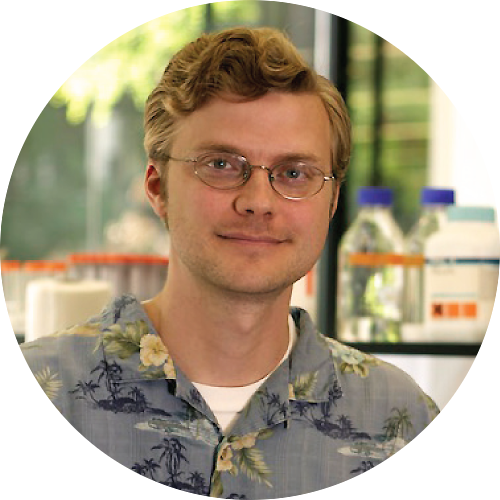Using the expression CMSL compact mass spectrometer
The CMSL is a high performance, easy to use, single quadrupole mass spectrometer with an extended mass range analysis capability to m/z 2000 — well-suited for large molecule applications such as the analysis of proteins. Its small footprint makes it the instrument of choice for space-restricted laboratories and it is more affordable than comparable MS systems. The CMSL brings the analytical benefits of mass spectrometry to more scientists than ever before.
Register to download the application note and see how LC/MS analysis using the expression CMSL and a denaturing solvent phase is a powerful tool in the analysis of protein mixtures and antibodies.
Q: What is the focus of your lab’s research?
A: Reach Separations is a contract research organization that services chemical, agricultural, pharmaceutical and academic clients.
Capability developed around expertise in separation science, specifically purification/prep.
Q: What previous workflow challenges did you experience?
A: Needed a tool to confirm quality of material (in and out).
Q: Why did you incorporate the expression CMS into your laboratory?
A: We selected the expression CMS for several reasons; proper MS Detector at an attractive price as well as its compact size because our lab space is limited. Advion’s technical support and service is exceptional. Easy to integrate with our wide range of equipment. Vendor relationship that is two way, Advion listens to our needs and ideas.
Q: Who Would you Recommend to purchase the expression CMS?
A: Anyone who needs a reliable mass spectrometer upgrade/addition for existing equipment.

Q: WHat is tHe focuS of your lab’S reSearcH?
A: The group has comprehensive experiences for undertaking radiotracer experiments, different spectroscopic techniques, characterization of colloid-chemical properties and in vitro/in vivo studies in view of the development and characterization of novel radiotracers, including functionalized nanoparticles. The design and development of chemically, metabolically and radiolytically stable radiometal complexes on the basis of 64Cu/67Cu is of special interest. Furthermore, polynuclear metal compounds (polyoxometalates, Re clusters) for anti-tumor activity, photosensitizing, and radiation-sensitizing properties are under investigation. The characterization of binding and transport behavior of novel receptors by solvent extraction studies represents one main topic.
Q: WHAT PREVIOUS WORKFLOW CHALLENGES DID YOU EXPERIENCE?
A: The development of new bifunctional chelating agents and relevant target-seeking bio-conjugates requires novel synthetic strategies and the improvement of known pathways as well. For the successful achievement of this goal, ‘real-time’ characterization of main and side-products is of particular importance.
Q: WHY DID YOU INCORPORATE THE EXPRESSION CMS INTO YOUR LABORATORY?
A: The Advion expression compact mass spectrometer rapidly provides reliable mass data in a stand-alone modus and coupled to UPLC/HPLC systems, respectively. Sample handling and measurement are straightforward. PhD students appreciate both the ‘in-time’ information about success and failure in developing novel compounds. I recommend to all groups requiring immediate access to reliable mass data for the characterization of novel compounds.

Q: What is the focus of your lab’s research?
A: The mass spectrometry facility here at Boston College’s main focus is as a core lab, open to all users, both undergraduate and graduate students alike.
Our main research interests include the application of mass spectrometry as a routine tool for chemistry/chemical biology; exploring new research applications for mass spectrometry; and the use of open-air ionization methods for the analysis of pharmaceutical, biological, drug and chemical analysis.
Q: What was your previous work flow or challenges?
A: As a core lab we have a large number of samples being run and there is a constant need to change ionization sources.
Q: Why did you incorporate the expression® CMS into your laboratory?
A: The expression® has allowed us to take the workload of the other more expensive instruments by incorporating it as an open access instrument. With minimal training, the students are able to run their own samples, as not to slow down their research.
Due to the instrument size and speed at which it pumps down, we are able to move the instrument directly to the classroom for students to use.
Economic adulteration of milk involves adulteration with nitrogen-rich compounds to interfere with the widely used Kjeldahl protein assay and in�ate the total protein content result for economic gains. The economic adulteration issue garnered global attention during the melamine scandal in 2007 which resulted in the sickening and deaths of infants fed with adulterated milk powder. Therefore the ability to rapidly screen milk ingredients in the manufacturing plants for potential economic adulterants is becoming increasingly important.
The current analytical method of choice is based on UPLC-MS/MS which is both expensive and requires considerable expertise for routine use. A simpler and more cost-effective alternative for frontline screening has been developed. The method uses HILIC-based HPLC and single quadrupole mass spectrometry detection to determine the presence of melamine, cyromazin, ammelide and ammeline in milk-based protein commodities.
Register to download this presentation developed by Advion and Abbott Nutrition.
Regardless of the legal status of cannabis and its chemical compounds, both the quality control in legal markets as well as the law enforcement of it’s illegal status require simple, unequivocal and legally defendable analysis methods for the detection and quantification of its major chemical compounds.
Whenever a detector of high selectivity and sensitivity is required, a mass spectrometry based analysis workflow is usually the method of choice and we here demonstrate the analysis of delta9-Tetrahydrocannabinol (THC), Canabidiol (CBD) and Canabinol (CBN) utilizing a novel compact mass spectrometer (expression-S, Advion, NY) coupled to ultra-high performance liquid chromatography (UHPLC) or thin layer chromatography (TLC).
Register to download the presentation featured at ASMS 2014.
The purpose of this study was to evaluate the positive and negative electrospray (ESI) and atmospheric pressure chemical ionization (APCI) LC/MS ion current response from a representative synthetic mixture of standard pharmaceutical compounds. The selected drup compounds were prepared as an equimolar mixture and analyzed by an optimized gradient LC/MS procedure using a novel compact mass spectrometer. The total and extracted ion current chromatographic peaks were compared between ESI and APCI in both positive and negative ionization modes. The results from this study shed some light on the relative merits of APCI vs ESI as well as the importance of the optimal ionization polarity for the LC/MS determination of the selected acidic and basic small molecule drugs. We also note some differences in adduct formation between these two API techniques.
Q: What is the focus of your lab’s research?
A: To address unresolved questions in DNA chemical biology, our group develops molecular probes for characterizing the structure, function, and dynamics of nucleic acids in vivo. Daily work in our lab relies heavily upon the rational design and synthesis of new organic compounds and their metal-containing complexes.
Q: What previous workflow challenges did you experience?
A: One major challenge to our workflow is the rapid identification of new target molecules that are often prepared as complex mixtures.
Q: Why did you incorporate the expression CMS into your laboratory?
A: We chose the expression CMS as a rapid and sensitive screening tool to identify new target molecules from the chromatographic separation of crude reaction mixtures. Given the exceptionally high sensitivity of this system, desired compounds that are initially made in trace quantities can be easily identified.

Q: What is the focus of your lab’s research?
A: The development of macromolecular materials that combine synthetic polymerization techniques with the capacity of peptides and other biologically relevant molecules to participate in supramolecular interactions will lead to a variety of new responsive materials. When applied in vivo, a vital characteristic of these new materials will be their biodegradability, allowing the carrier to break down into benign metabolites. My lab focuses on the synthesis of biodegradable polymeric and self-assembling structures and their application in a broad variety of fields, including regenerative medicine, cancer therapeutics, drug delivery, and signaling gas delivery.
Q: What was your previous work flow or challenges?
A: We make and purify a lot of peptides, some of which are unstable under preparative HPLC purification conditions. By using rapid MS analysis to confirm the identity of an HPLC peak, we can quickly workup the product-containing fractions before they decompose. This was nearly impossible before we moved to the Advion system. Our peptides routinely have molecular weights in excess of 2000 g/mol, which we can identify by looking at multiply charged species. We use the expression® CMS for characterizing peptides several times during a difficult synthesis to optimize our synthesis and purification methods. My group has also found that the CMS system is extremely helpful in small molecule synthesis, where we use it to quickly verify that a product has formed in a reaction before proceeding to workup and isolation steps.
Q: Why did you incorporate the expression® CMS into your laboratory?
A: We incorporated the CMS system in our lab to speed up workflow and to enable us to synthesize peptides and peptide conjugates that are deliberately unstable. It has sped up small molecules and peptide synthesis as well as allowed us to do qualitative decomposition studies on our compounds.
Q: Who would you recommend to purchase the expression® CMS?
A: I think that nearly any lab that does significant small molecule and/or peptide synthesis would benefit from this instrument. There is no substitute for having a mass spectrometer a few steps away from your bench. Analyses require very little sample and are often as quick as a few minutes, making the CMS system a more efficient analytical technique than 1H NMR for rapid product confirmation.
Ultra (high) performance liquid chromatography (UPLC/UHPLC) is a relatively new technique, and is valued for its speed, efficiency and the quality of information provided. Many synthetic and medicinal chemistry laboratories are moving to this process to improve their workflows and save time.





